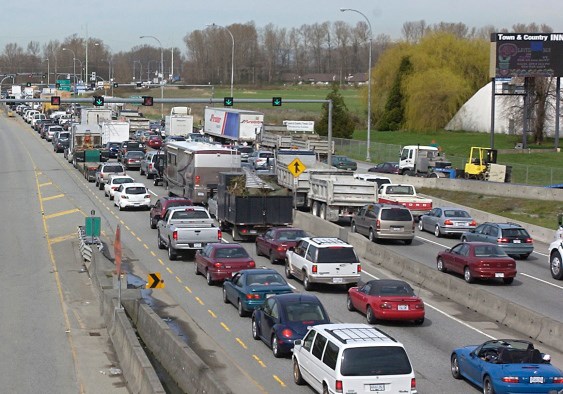Richmond city council took a significant step in its opposition to a replacement bridge to Delta by stating it prefers a new or improved George Massey Tunnel.
Only councillors Ken Johnston — who is the president of Novex, a local delivery company — and Alexa Loo opposed the motion tabled at a committee on Monday evening.
The stated opposition to the replacement bridge came after a presentation by Geoff Freer, executive project director of the George Massey Tunnel Replacement Project.
“It seems to me this (bridge) is going to be tremendous in terms of economic growth by getting more cars moving,” Loo told Freer.
But committee chair, Mayor Malcolm Brodie, led a chorus of concerns ranging from agricultural land preservation, Port Metro Vancouver’s role in the project, the expectations placed on the City of Richmond and what, if anything, is to be done about the Oak Street Bridge bottleneck.
Freer contended about 60 per cent of traffic through the tunnel originates from, and is destined for, Richmond.
Freer said the Oak Street Bridge problem is a City of Vancouver matter and his team would be speaking to Vancouver planners. He said queues at the Oak Street Bridge will be a “little longer” after the new bridge is built.
“You say this bridge is a solution to many problems, but you’re not addressing this one,” said Brodie.
Coun. Derek Dang said the Oak Street Bridge must be addressed for the replacement bridge to make sense, even if 60 per cent of the traffic is related to Richmond.
“You’re moving more cars into an area known to stop cars, I mean, what is the purpose? It’s a bridge going to a big stop sign. This has to be the priority,” he said.
Coun. Bill McNulty said Delta is “rubbing its hands” granted the bridge is “moving the parking lot” from the south side of the Fraser River to the north side.
The Province of B.C. has stated a $3.5 billion, 10-lane bridge will replace the tunnel by 2022, following an environmental assessment. The bridge will be built and tolled via a public-private partnership lasting 30 years. The bridge will be complimented by the widening of Highway 99 in Richmond, which is to include five upgraded overpasses (Bridgeport, Shell, Westminster, Blundell and Steveston) and three integrated transit stops. It will also feature bike lanes and be capable of rapid transit expansion.
“The region continues to grow, the economy is growing, there’s more housing and that all contributes to congestion,” said Freer.
He added that the project will result in a net benefit to farmland, however when asked how much and whether the land was as good for farming as the land that is being lost, Freer wasn’t able to give any details.
“You should have a complete plan,” said McNulty, while also questioning the efficacy of transit stops in light of a lack of provincial funding for more buses.
Coun. Harold Steves questioned why the bridge didn’t include light rail, to which Freer could not answer.
Steves then contended the port wants the bridge to bring larger ships into the river by being able to dredge deeper at the tunnel.
Freer said a nearby Metro Vancouver water main also prevents deeper dredging.
Freer, when asked by Brodie, said the province has had discussions with Metro Vancouver about the water main, but did not elaborate.
“The construction of this bridge is totally for the industrialization of the Fraser. Richmond did not ask for this tunnel to be removed,” said Steves.
Coun. Carol Day, who opposes the bridge, raised concerns that the location was in a volatile area of the river, prone to liquefaction during an earthquake.
Freer said a bridge would be suitable in the location as concrete pilings would extend 70 metres into the ground, well past the 20 metres of unstable sand. He noted the province recently decided not to upgrade the tunnel’s seismic stability by removing the sand beneath it with gravel, as it proved too costly.
Presently, the level of seismic event that would lead to a tunnel failure is estimated at one in 275 years whereas the current design standard for the new bridge will be one in 2,475 years.
A public open house on the environmental assessment for the bridge takes place next Tuesday at the Sandman Signature Hotel Vancouver Airport from 2-8 p.m.
There is no open house for the actual project itself but comments on the Project Description and Key Areas of Study document, released in December, can be made online (EAO.gov.bc.ca) until Feb. 15.
Meanwhile, the City of Richmond has asked the province for more time to submit its own feedback.



